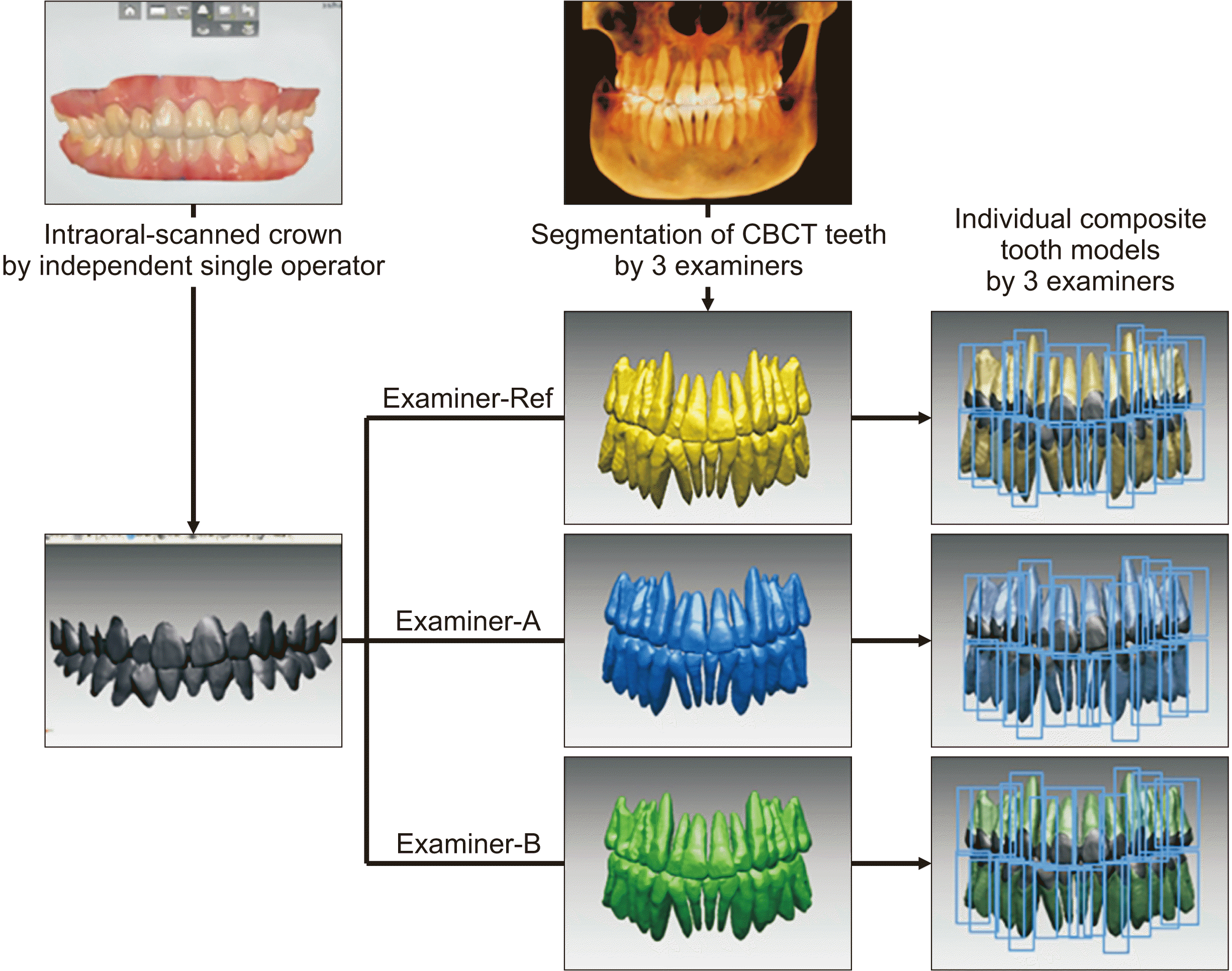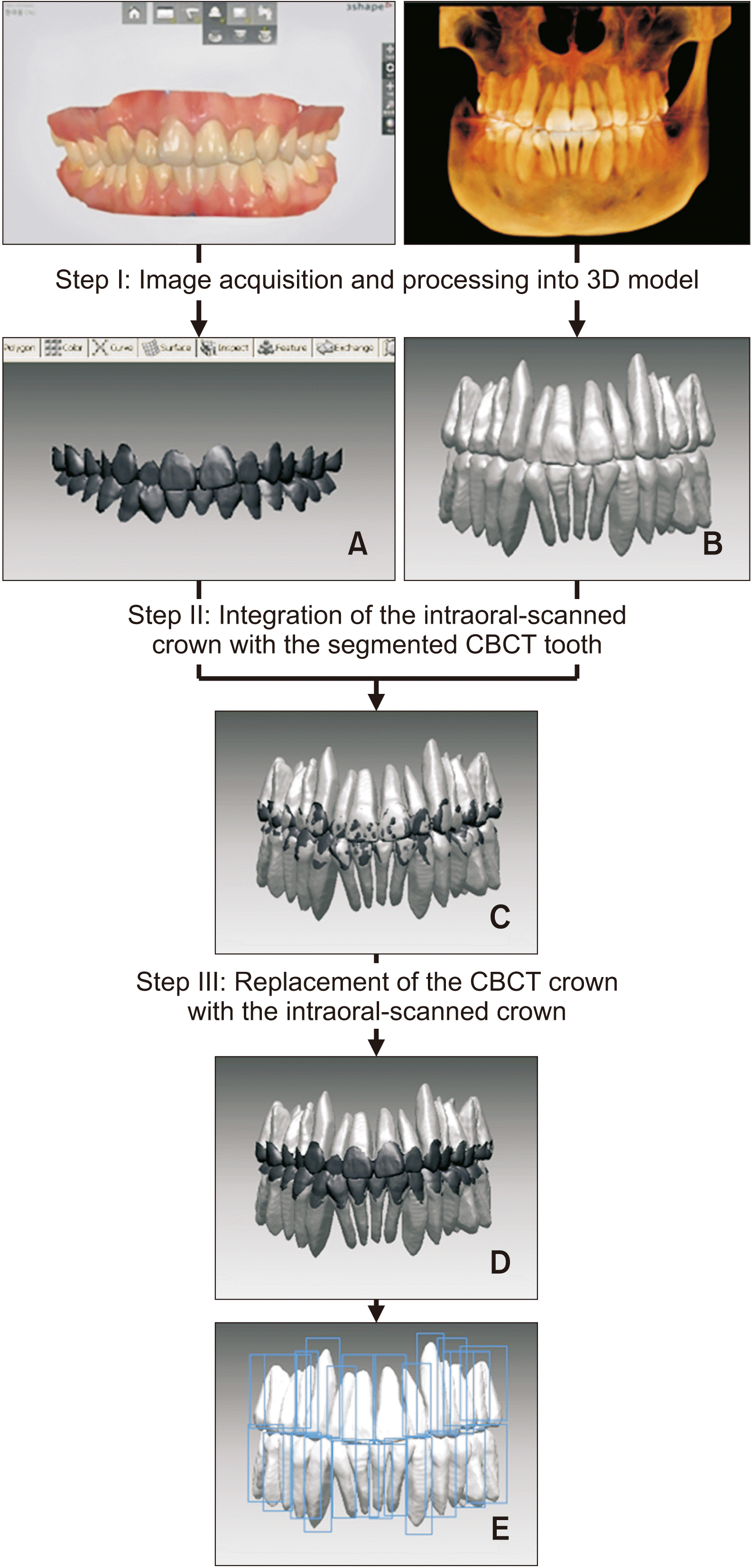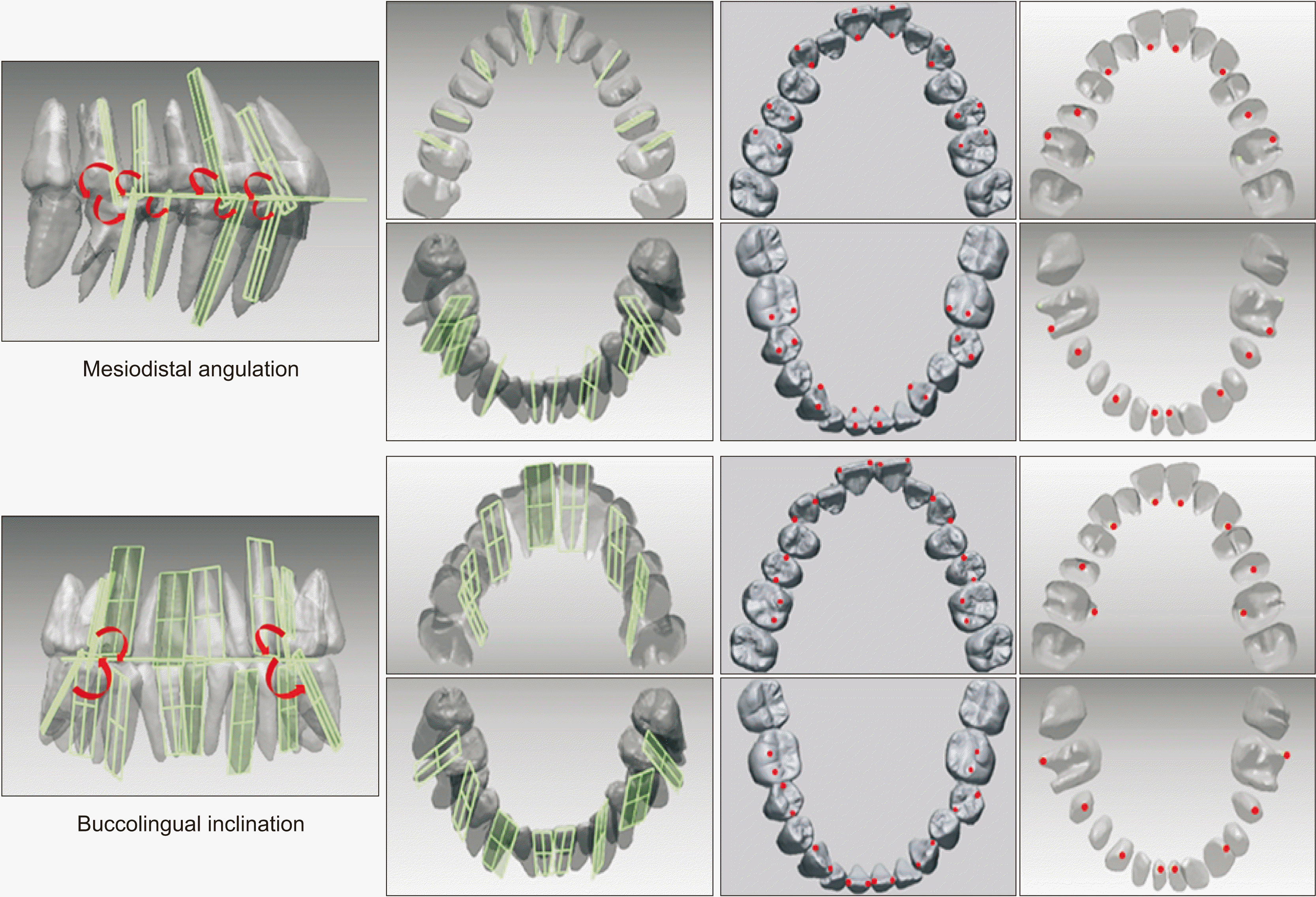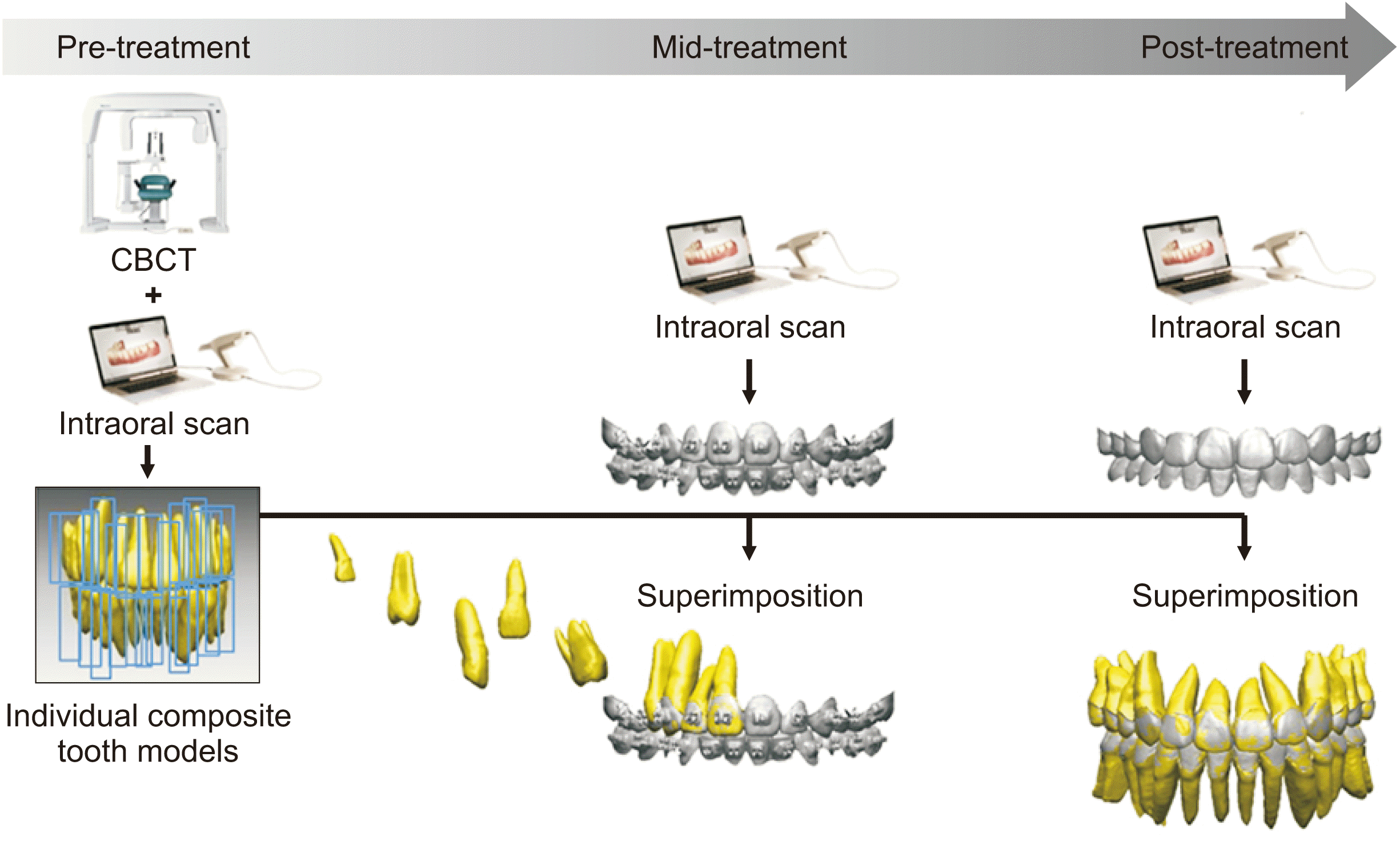1. Garcia-Figueroa MA, Raboud DW, Lam EW, Heo G, Major PW. 2008; Effect of buccolingual root angulation on the mesiodistal angulation shown on panoramic radiographs. Am J Orthod Dentofacial Orthop. 134:93–9. DOI:
10.1016/j.ajodo.2006.07.034. PMID:
18617108.

2. Mckee IW, Glover KE, Williamson PC, Lam EW, Heo G, Major PW. 2001; The effect of vertical and horizontal head positioning in panoramic radiography on mesiodistal tooth angulations. Angle Orthod. 71:442–51.
3. Song IT, Cho JH, Chae JM, Chang NY. 2011; Evaluation of mesiodistal tooth axis using a CBCT-generated panoramic view. Korean J Orthod. 41:255–67. DOI:
10.4041/kjod.2011.41.4.255.

4. Lascala CA, Panella J, Marques MM. 2004; Analysis of the accuracy of linear measurements obtained by cone beam computed tomography (CBCT-NewTom). Dentomaxillofac Radiol. 33:291–4. DOI:
10.1259/dmfr/25500850. PMID:
15585804.

5. Tong H, Enciso R, Van Elslande D, Major PW, Sameshima GT. 2012; A new method to measure mesiodistal angulation and faciolingual inclination of each whole tooth with volumetric cone-beam computed tomography images. Am J Orthod Dentofacial Orthop. 142:133–43. DOI:
10.1016/j.ajodo.2011.12.027. PMID:
22748999.

6. Ender A, Mehl A. 2011; Full arch scans: conventional versus digital impressions--an in-vitro study. Int J Comput Dent. 14:11–21.
7. Hayashi K, Sachdeva AU, Saitoh S, Lee SP, Kubota T, Mizoguchi I. 2013; Assessment of the accuracy and reliability of new 3-dimensional scanning devices. Am J Orthod Dentofacial Orthop. 144:619–25. DOI:
10.1016/j.ajodo.2013.04.021. PMID:
24075671.

8. Sun L, Lee JS, Choo HH, Hwang HS, Lee KM. 2018; Reproducibility of an intraoral scanner: a comparison between in-vivo and
ex-vivo scans. Am J Orthod Dentofacial Orthop. 154:305–10. DOI:
10.1016/j.ajodo.2017.09.022. PMID:
30075932.
9. Lim SW, Hwang HS, Cho IS, Baek SH, Cho JH. 2020; Registration accuracy between intraoral-scanned and cone-beam computed tomography-scanned crowns in various registration methods. Am J Orthod Dentofacial Orthop. 157:348–56. DOI:
10.1016/j.ajodo.2019.04.031. PMID:
32115113.

10. Macchi A, Carrafiello G, Cacciafesta V, Norcini A. 2006; Three-dimensional digital modeling and setup. Am J Orthod Dentofacial Orthop. 129:605–10. DOI:
10.1016/j.ajodo.2006.01.010. PMID:
16679200.

11. Guo H, Zhou J, Bai Y, Li S. 2011; A three-dimensional setup model with dental roots. J Clin Orthod. 45:209–16. quiz 235–6. PMID:
21785205.
12. Kihara T, Tanimoto K, Michida M, Yoshimi Y, Nagasaki T, Murayama T, et al. 2012; Construction of orthodontic setup models on a computer. Am J Orthod Dentofacial Orthop. 141:806–13. DOI:
10.1016/j.ajodo.2011.10.027. PMID:
22640682.

13. Lee RJ, Pham J, Choy M, Weissheimer A, Dougherty HL Jr, Sameshima GT, et al. 2014; Monitoring of typodont root movement via crown superimposition of single cone-beam computed tomography and consecutive intraoral scans. Am J Orthod Dentofacial Orthop. 145:399–409. DOI:
10.1016/j.ajodo.2013.12.011. PMID:
24582031.

14. Lee RJ, Weissheimer A, Pham J, Go L, de Menezes LM, Redmond WR, et al. 2015; Three-dimensional monitoring of root movement during orthodontic treatment. Am J Orthod Dentofacial Orthop. 147:132–42. DOI:
10.1016/j.ajodo.2014.10.010. PMID:
25533080.

15. Lee RJ, Pi S, Park J, Devgon D, Nelson G, Hatcher D, et al. 2018; Accuracy and reliability of the expected root position setup methodology to evaluate root position during orthodontic treatment. Am J Orthod Dentofacial Orthop. 154:583–95. DOI:
10.1016/j.ajodo.2018.05.010. PMID:
30268268.

17. Schunk DH. 2012. Learning theories: an educational perspective. 6th ed. Pearson Education;Boston: p. 38–40.
18. Wang C, Liu Y, Wang S, Wang Y, Zhao Y. 2018; Evaluation of in vivo digital root reconstruction based on anatomical characteristics of the periodontal ligament using cone beam computed tomography. Sci Rep. 8:269. DOI:
10.1038/s41598-017-18592-4. PMID:
29321613. PMCID:
PMC5762886.

19. Ye N, Long H, Xue J, Wang S, Yang X, Lai W. 2014; Integration accuracy of laser-scanned dental models into maxillofacial cone beam computed tomography images of different voxel sizes with different segmentation threshold settings. Oral Surg Oral Med Oral Pathol Oral Radiol. 117:780–6. DOI:
10.1016/j.oooo.2014.02.022. PMID:
24767699.

20. Marmulla R, Wörtche R, Mühling J, Hassfeld S. 2005; Geometric accuracy of the NewTom 9000 Cone Beam CT. Dentomaxillofac Radiol. 34:28–31. DOI:
10.1259/dmfr/31342245. PMID:
15709102.

21. Sang YH, Hu HC, Lu SH, Wu YW, Li WR, Tang ZH. 2016; Accuracy assessment of three-dimensional surface reconstructions of in vivo teeth from cone-beam computed tomography. Chin Med J (Engl). 129:1464–70. DOI:
10.4103/0366-6999.183430. PMID:
27270544. PMCID:
PMC4910372.









 PDF
PDF Citation
Citation Print
Print





 XML Download
XML Download